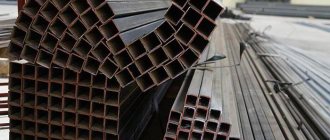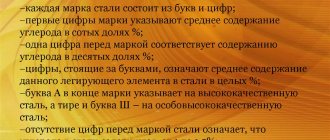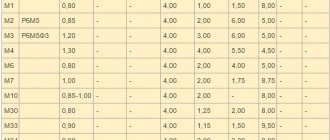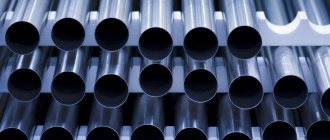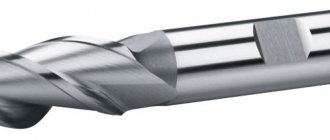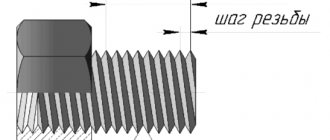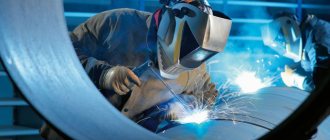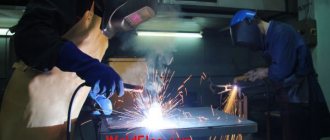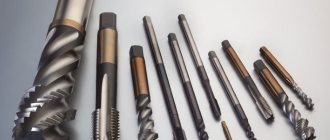For all types of activities in any way related to the use of steel, it is important to distinguish between their grades, purpose and other properties indicated in the index. Numerical and letter designations allow you to quickly and without additional clarification understand the properties, characteristics and purpose of various types of metal. This article outlines the fundamental principle of classification and an easy way to read the markings of the most common steels in practice.
Steel is an alloy of iron and carbon, its share in the metal cannot exceed 2.14%. Based on the volume of carbon, steels are distinguished with low (0.25%), medium (up to 0.6%) and high (over 0.6%) amounts of carbon, since it significantly affects the characteristics of the alloy, increasing hardness but reducing strength characteristics.
In addition, steels are classified:
- Carbon alloys in accordance with GOST 380-71, as well as GOST 1050-75;
- Alloyed with various metals according to the requirements of GOST 4543-71, 5632-72 and 14959-79.
Alloying the metal with various elements makes it possible to give it improved performance properties, for example, resistance to friction (bearings), electromagneticity, corrosion, etc. Alloyed steel grades, like carbon steel, are divided into low (2.5%) and medium (2.5-10%) and highly alloyed (more than 10%).
Steel grades are subject to mandatory marking according to state standards. There are several labeling systems in the world, for example, adopted in the USA and most Western countries; the Russian (USSR) system will be considered here as the most relevant for the Russian Federation and neighboring countries.
Types of steels and features of their markings
Various areas of application of steel require that it have strictly defined properties - physical, chemical. In one case, the highest possible wear resistance is required, in others, increased resistance to corrosion, in others, attention is paid to magnetic properties.
There are many types. The bulk of the smelted metal goes into the production of structural steel, which includes the following types:
- Construction Low alloy steel with good weldability. The main purpose is the production of building structures.
- Spring. They have high elasticity, fatigue strength, and fracture resistance. Used for the production of springs and leaf springs.
- Bearing. The main criterion is high wear resistance, strength, low fluidity. It is used for the production of units and components of bearings for various purposes.
- Corrosion resistant (stainless). High-alloy steel with increased resistance to aggressive substances.
- Heat resistant. It is distinguished by its ability to work for a long time under load at elevated temperatures. Area of application: engine parts, including gas turbine engines.
- Instrumental. Used for the production of metal and woodworking and measuring instruments.
- Fast cutting. For the manufacture of tools for metalworking equipment.
- Cementable. It is used in the manufacture of parts and assemblies operating under high dynamic loads under conditions of surface wear.
Steel classification
When deciphering the designations, it is necessary to take into account that each of the types corresponds to a strictly defined letter in the marking.
Characteristics of steel grade St3kp
St3kp - Structural carbon steel of ordinary quality, welds well, welding is carried out without heating and without subsequent heat treatment, welding methods: manual arc welding, automatic submerged arc welding and gas protection, KTS, ESW. For thicknesses greater than 35 millimeters, heating and subsequent heat treatment are recommended; it is prone to flake sensitivity, and there is no tendency to temper brittleness. Cutting machinability in the hot-rolled state at HB 124 and σ = 410 MPa. Kυ tv.sp. = 1.8 and Kυ b.st. = 1.6, has found its application in lightly loaded elements, in welded and non-welded structures and parts operating at temperatures from -40 to 400 degrees, used in shaped profiles for cars, used in the same way as class A-I (A240) fittings . Forging at temperatures from 1300 to 750 0C, cooling is carried out in air. According to GOST 27772-88, steel St3kp corresponds to steel for building structures S235
Classification by chemical composition
The main alloying additives are metals. By varying the quantitative composition of additives and their mass fraction, a wide variety of steel grades are obtained. Pure iron itself has low technical properties. Low mechanical strength and high susceptibility to corrosion require the introduction of additional substances into the alloy composition, which are aimed at improving one of the qualities, or several at once.
Often, the improvement of some characteristics entails the deterioration of others. Thus, high-alloy stainless steels may have low mechanical strength, while high-quality carbon steels, along with high strength, receive weakened corrosion properties.
As mentioned above, one of the classifications of steel grades is its chemical composition. The main components of all steels without exception are iron and carbon, the content of which should not exceed 2.14%. Depending on the amount and proportions of additives, the iron content in the composition should be at least 50%.
Based on the amount of carbon contained, steels are classified into three groups:
- Low-carbon – carbon content less than 0.25%;
- Medium carbon – 0.25-0.6% carbon;
- High carbon, with a carbon content of more than 0.6%.
An increase in the percentage of carbon increases the hardness of the metal, but at the same time its strength decreases.
To improve performance, a certain amount of chemical elements is introduced into the alloy. Such steels are called alloyed. For alloy steels there is also a division into three groups:
- Low alloy, containing additives up to 2.5%;
- Medium alloyed, which contain from 2.5 to 10% alloying elements;
- Highly alloyed. The content of alloying impurities varies from 10 to 50%.
The marking of steels reflects the presence and percentage of alloying additives. When deciphered, each element is assigned a specific letter, next to which there is a number corresponding to its content as a percentage. The absence of numbers indicates that the additive is present in the alloy in an amount of less than 1-1.5%. The presence of carbon in the composition is not reflected, since it is included in all compositions, but its content is indicated at the very beginning of the labeling.
The marking can also indicate the purpose of the alloy. Since this classification also uses letter designations, the order of their arrangement is regulated - at the beginning, middle and end of the marking.
Types and designation of cast iron
This material is a compound of C and Fe, with the content of the first element exceeding 2.14%. Cast iron is characterized by the presence of elements in the form of impurities absolutely identical to those contained in steel.
The division into types of a given metal is made taking into account the state of the carbon present in it:
| Type of cast iron | Description | Markings used |
| White | Carbon is in the form of carbide | Warhead |
| Grey | Graphite having a plate-like or worm-like shape | midrange |
| High strength | Nodular graphite | HF |
| Malleable | Flaky graphite | CC |
Classification of cast iron, marking and description of properties
In addition to alphabetic symbols, cast iron is designated by 2 numbers characterizing the minimum tensile strength δv in MPa-10.
Classification by purpose
The classification of steel types by purpose has already been given above. Marking of structural steels includes the following designations:
- Construction - denoted by the letter C and numbers characterizing the yield strength.
- Bearing - designated by the letter Ш. Next comes the designation and content of alloying additives, mainly chromium.
- Instrumental unalloyed - denoted by the letter U and carbon content in tenths of a percent.
- High-speed - denoted by the letter P and symbols of alloying components.
- Unalloyed structural steel has the symbols Cn and a number indicating the carbon content in tenths or hundredths of a percent.
Classification of steel by purpose
The remaining varieties, including tool grades made of alloy steels, do not have special designations other than their chemical composition, so the decoding and purpose of individual types can only be determined from reference literature.
Foreign analogues of steel grade St3kp
| USA | A283A, A284Gr.D, A57033, A57036, A573Gr.58, A611Gr.C, K01804, K02001, K02301, K02502, K02601, K02701, K02702 |
| Germany | 1.0036, 1.0036, 1.0116, Fe360B, Fe360D1, RSt37-2, S235J2G3, S235JRG1, USt37-2, USt37-2G |
| Japan | SS400, STKM12A |
| France | 4360-40D, E24-3, E24-4, S235J0, S235J2G3, S235J2G4, S235JRG1 |
| England | 1449-3723CR, 235JRG1, 4360-40B, 4449-250, Fe360B, Fe360D1FF, HFS4, HFW4, S235J2G3 |
| Canada | 230G |
| European Union | Fe37-3FN, Fe37-3FU, Fe37B1FN, Fe37B1FU, Fe37B3FN, Fe37B3FU, S235J2G3, S235JRG1 |
| Italy | Fe360B, Fe360BFU, Fe360C, Fe360CFN, Fe360D, Fe360DFF, Fe37-2, S235J0, S235J2G3, S235J2G4, S235JRG1 |
| Belgium | FE360B, FED1FF |
| Spain | AE235B, AE235D, Fe360B, Fe360D1FF, S235J2G3, S235JRG1 |
| China | A3, Q235, Q235A, Q235A-F, Q235A-Z, Q235B, Q235B-Z |
| Sweden | 1311, 1312, 1313 |
| Bulgaria | BSt3kp, BSt3ps, Ew-08AA, S235J2G3, S235JRG1, WSt3kp |
| Hungary | A1, B38.24, B38.24B, Fe235BFU, S235J2G3, S235JRG1 |
| Poland | SS400, St3SX, St3SY, St3W |
| Romania | OB37, OL37.1 |
| Czech | 10216, 11373, 11378 |
| Austria | St37F |
- Structural steel
- Tool steel
Classification by structure
The structure of steel refers to the internal structure of the metal, which can vary significantly depending on heat treatment conditions and mechanical influences. The shape and size of grains depend on the composition and ratio of alloying additives and production technology.
The basis of steel grains is a crystal lattice of iron, which includes atoms of impurities - carbon, metals. Carbon can form solid solutions in the crystal lattice, or it can create chemical compounds, carbides, with iron.
Metal additives exist in the form of solutions, and many of them affect the state of the carbon solution.
The structure of steel changes with temperature changes. These changes are called phases. Each phase exists in a certain temperature range, but alloying additives can significantly shift the boundaries of the transition of one phase to another.
The following are the main phases of the state of the metal:
- Austenite. Carbon atoms are located inside the iron crystal lattice. This phase exists in the range of 1400-700 °C. If the composition contains from 8 to 10% nickel, the austenite phase can persist at room temperature.
- Ferrite. Solid solution of carbon in iron.
- Martensite. Supersaturated carbon solution. This phase is characteristic of hardened steel.
- Bainite. The phase is formed by rapid cooling of austenite to a temperature of 200-500 °C. Characterized by a mixture of ferrite and iron carbide.
- Perlite. Equilibrium mixture of ferrite and carbide. It is formed when austenite is slowly cooled to a temperature of 727 °C.
Steel structure
The phases of the metal structure characterize its physical properties, depending on which the class of steel is determined - structural, foundry, and so on.
Impact strength of steel St3kp
| Delivery condition, heat treatment | +20 | 0 | -10 | -20 | -30 |
| Sheets 10-12 mm thick | 89-100 | 60-85 | 12-69 | 13-53 | 6-10 |
| Sheets 16-20 mm thick | 40-140 | 15-71 | 9-16 | 8-12 | |
| Sheets 30-32 mm thick | 30-115 | 8-13 | 6-13 | 7-9 | |
| Sheets up to 12 mm thick (shaped rolled products) | 64-149 | 83-112 | 83-114 | 14-63 |
Quality classification
Alloyed and unalloyed steel within each grade differs in quality, which depends on the production technology and the quality of the starting materials.
The quality of steel is particularly affected by impurities that remain in it during the reduction of iron from ore concentrates. Phosphorus and sulfur mainly negatively affect the quality of steel. According to their content, steel of ordinary quality and high-quality steel are classified, at the end of which there is the letter A. The phosphorus content in high-quality steel does not exceed 0.025%.
Classification by deoxidation method
When steel is smelted, a certain amount of oxygen remains in it as part of the iron oxides. To reduce the amount of oxygen and restore iron from oxides, a deoxidation reaction is used, in which compounds that are more active in interacting with oxygen than iron are added to the molten metal. During the reaction, the released oxygen also reacts with carbon, resulting in the formation of carbon dioxide, which is released in the form of bubbles.
Depending on the amount of deoxidizing agents and the duration of the process, three types of the final alloy can be distinguished:
- Boiling steel. As a result of the minimal use of additives and reaction time, the yield of finished products is increased, which, at the same time, is of low quality;
- Calm steel. Metal that has completely undergone deoxidation processes. It is of high quality, but expensive to produce due to the high cost of reagents and reduced product yield;
- Semi-quiet steel. An intermediate option with the optimal combination of quality and cost.
When producing an assortment of steel grades from metal of varying degrees of deoxidation, special marking of materials is used, respectively, with the symbols “sp”, “kp” and “ps”.
Production quality level
In accordance with the characteristics of the steel manufacturing process: manufacturability, uniformity of structure, chemical and physical characteristics, the percentage of saturation of the composition with additional elements (P and S) and gases, the material is classified into one of 4 groups:
| Steel group depending on the level of production quality | Phosphorus concentration (P), % | Sulfur concentration (S), % |
| Ordinary quality | ≤ 0,07 | ≤ 0,06 |
| Quality | ≤ 0,035 | ≤ 0,035 |
| High quality | ≤ 0,025 | ≤ 0,025 |
| Particularly high quality | ≤ 0,025 | ≤ 0,015 |
Classification of steel by quality degree
The first of the above groups can also be divided into 3 subgroups, which are directly dependent on the supply of metal:
- “A” – in this case, phosphorus and carbon indicators are overestimated. Thus, the supply of an alloy of this subgroup is carried out according to mechanical characteristics;
- "B". Unlike “A”, the chemical composition plays the main role here;
- "IN". A combined subgroup, representing both the first and second options.
Marking of steels according to Russian standards
Marking steel according to Russian standards makes it possible to determine the composition of the metal and, in part, whether it belongs to a certain type.
If the presence of carbon in steel is more than 1%, its amount is not indicated in the marking. The steel grade includes letter designations of alloying additives indicating their quantity in tenths and hundredths of a percent, but if the component content is less than 1.5%, then only the letter designation is present in the marking.
In addition to the chemical composition, the marking contains symbols characterizing the purpose of the steel and the degree of its quality.
Marking of steels according to American and European systems
Marking of steels produced domestically and in the post-Soviet space makes it possible to approximately determine the composition, purpose and characteristics without resorting to reference literature. In American and European standards, such decoding is, for the most part, absent. This is due to the large number of organizations involved in the standardization of metal products.
For the most part, the designation of steel according to American and European standards does not indicate the chemical composition. Types of steel according to their intended purpose are characterized by an alphabetic or digital code, which can be deciphered using reference literature.
Only in the European standard EN10027 there is an option for marking alloys by chemical composition, which is closely similar to domestic designations.
Designations of alloying elements
In order to recognize the qualitative and quantitative composition from the markings, letter designations are used for alloying elements.
Basically, Russian letters correspond to the names of elements, although there are exceptions, since there are elements that begin with the same letters. The table of alloying elements is as follows. Designation of alloying elements in steels
| IN | Tungsten | B | Niobium |
| TO | Cobalt | E | Selenium |
| M | Molybdenum | R | Bor |
| N | Nickel | F | Vanadium |
| T | Titanium | C | Zirconium |
| X | Chromium | YU | Aluminum |
| G | Manganese | A | Nitrogen |
| D | Copper | WITH | Silicon |
As can be seen from the table, it contains two non-metals - silicon and nitrogen, but no carbon. The presence of carbon is implied in the composition of any steel, therefore the designation indicates only its content
Deoxidation index
This process is a procedure for removing oxygen from a metal that is in a liquid state. According to this indicator, it is customary to distinguish 3 types of this material:
- calm. In this case, the process is carried out thanks to the participation of aluminum, silicon and manganese. This type is designated “sp”;
- semi-quiet - a link located between the first and third varieties. Species marking: “ps”;
- boiling. This type of steel is characterized by a reduced level of deoxidation. It is spelled "kp".
An increase in the strength coefficient of the metal is achieved by heating it under the influence of the highest possible temperatures. Due to such external influence, steel ceases to be viscous and ductile. Under this condition, the possibility of an easier process of cutting the material disappears.
The influence of alloying elements on the properties of steel
| Austenitic | |||||||||||||
| steel grade | Carbon % | Silicon% | Manganese % | Phosphorus % | Sulfur% | Nickel % | Chrome % | Copper % | Niobium % | Titanium % | Nitrogen % | ||
| AISI 304 | ≤ 0,08 | ≤ 1,00 | ≤ 2,00 | ≤ 0,045 | ≤ 0,030 | 8,00-10,50 | 18,00-20,00 | – | – | – | – | ||
| AISI 321 | ≤ 0,08 | ≤ 1,00 | ≤ 2,00 | ≤ 0,045 | ≤ 0,030 | 9,00-12,00 | 17,00-19,00 | – | – | ≤ 0,7 | – | ||
| AISI 201 | <0,12 | ≤ 0,75 | 8,50-10,50 | ≤ 0,060 | ≤ 0,030 | 1,00-1,50 | 14,00-16,50 | ≤ 2,00 | – | – | ≤ 0,020 | ||
| AISI 202 | ≤ 0,08 | ≤ 0,75 | 7,00-8,00 | ≤ 0,060 | ≤ 0,010 | 4,00-5,00 | 15,00-17,50 | ≤ 1,50 | – | – | ≤ 0,010 | ||
| NTKD 11 | ≤ 0,10 | ≤ 1,00 | 5,50-7,50 | ≤ 0,045 | ≤ 0,015 | 3,50-5,50 | 17,00-18,00 | 1,50-3,50 | – | – | – | ||
| Ferritic | |||||||||||||
| AISI 430 | ≤ 0,12 | ≤ 0,75 | ≤ 1,00 | ≤ 0,040 | ≤ 0,030 | – | 16,00-18,00 | – | – | – | – | ||
| SUS 430J1L | ≤ 0,025 | ≤ 1,00 | ≤ 1,00 | ≤ 0,040 | ≤ 0,030 | – | 16,00-20,00 | 0,30-0,80 | 1,0 | – | ≤ 0,025 | ||
| JYH21CT (21Cr-Ti) | ≤ 0,015 | ≤ 1,00 | ≤ 1,00 | ≤ 0,040 | ≤ 0,030 | – | 20,00-23,00 | ≤ 0,43 | – | ≤ 0,3 | ≤ 0,015 | ||
| NSSC180 | ≤ 0,02 | ≤ 1,00 | ≤ 1,00 | ≤ 0,040 | ≤ 0,006 | ≤ 0,60 | 19,00-21,00 | 0,30-0,60 | 0,30-0,80 | – | ≤ 0,025 | ||
| Martensitic | |||||||||||||
| SUS 420 L | 0,16-0,25 | ≤ 1,00 | ≤ 1,50 | ≤ 0,040 | ≤ 0,010 | – | 12,00-14,00 | – | – | – | – | ||
| SUS 420 J2 | 0,36-0,42 | ≤ 1,00 | ≤ 1,00 | ≤ 0,040 | ≤ 0,010 | – | 12,50-14,50 | – | – | – | – | ||
Color coding
Color marking of steels is used to indicate rolled products. This is convenient when storing materials in warehouses and transporting them. Steels are marked with marks in the form of dots or stripes made with indelible paint. The color of the designations is selected from the table according to the purpose of the steel. In this case, the steel group and the degree of its deoxidation are not taken into account.
Example of steel color marking
Mechanical properties St3kp
| Type of delivery | Size | Eg. | sв | sT | d5 | y | KCU | Heat treatment |
| — | mm | — | MPa | MPa | % | % | kJ/m2 | — |
| Pipes, GOST 8696-74 | 363 | 235 | 23 | |||||
| Pipes, GOST 10705-80 | 372 | 225 | 22 | |||||
| Rolled goods, GOST 535-2005 | 360-460 | 195-235 | 24-27 | |||||
| Thick sheet, GOST 14637-89 | 360-460 | 195-235 | 24-27 | |||||
| Fittings, GOST 5781-82 | 373 | 235 | 25 | |||||
| Wire rod, GOST 30136-95 | 490-540 | 60 |
Examples of decoding markings
To make the decoding clearer, some of the most striking examples of marking should be given. Based on the examples, determining the steel grade in comparison with already known ones will not be a difficult task. Here are some types of steel with decoding symbols:
- 30ХГСА - decoding of the steel grade indicates that the alloy contains 0.3% carbon, as evidenced by the number at the beginning of the designation. Steel contains chromium (X), manganese (G), silicon (C), but their content is less than 1.5%. The symbol “A” at the end of the designation indicates that the steel is high quality.
- U8GA – tool steel with a carbon content of 0.8%. High quality with added manganese.
- R6M5F2K8 – high-speed steel. Contains 5% molybdenum, 2% vanadium, 8% cobalt. Chromium is contained in all high-speed steels in an amount of about 4%, so it is not included in the designation. Tungsten is also always present, but its content can vary, so in this brand its amount is 6%.
- St3sp5 - unalloyed structural steel, completely deoxidized - calm, category 5, that is, it can be used for the manufacture of load-bearing welded structures.
- HVG – HVG steel contains chromium, tungsten and manganese in an amount of about 1% and additional alloying elements, but their content is less than 0.5%.
Mechanical properties of St3kp at elevated temperatures
| Test temperature, °C | σ0.2, MPa | σB, MPa | δ5, % | ψ, % |
| Sheets 12 mm thick as delivered (cross-sectional samples) | ||||
| 20 | 205 | 385 | 37 | 60 |
| 100 | 190 | 370 | 27 | 59 |
| 200 | 175 | 430 | 21 | 51 |
| 300 | 160 | 450 | 23 | 49 |
| 400 | 150 | 395 | 35 | 62 |
